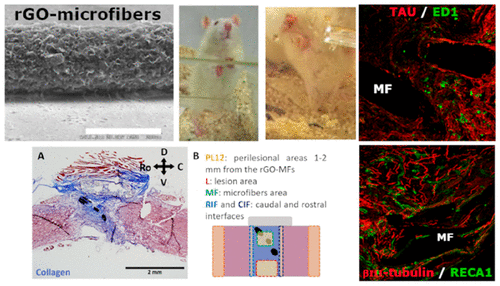当前位置:
X-MOL 学术
›
ACS Biomater. Sci. Eng.
›
论文详情
Our official English website, www.x-mol.net, welcomes your
feedback! (Note: you will need to create a separate account there.)
Graphene Oxide Microfibers Promote Regenerative Responses after Chronic Implantation in the Cervical Injured Spinal Cord
ACS Biomaterials Science & Engineering ( IF 5.4 ) Pub Date : 2020-03-16 , DOI: 10.1021/acsbiomaterials.0c00345 Ana Domínguez-Bajo 1 , Ankor González-Mayorga 2 , Elisa López-Dolado 2, 3 , Carmen Munuera 1 , Mar García-Hernández 1 , María Concepción Serrano 1
ACS Biomaterials Science & Engineering ( IF 5.4 ) Pub Date : 2020-03-16 , DOI: 10.1021/acsbiomaterials.0c00345 Ana Domínguez-Bajo 1 , Ankor González-Mayorga 2 , Elisa López-Dolado 2, 3 , Carmen Munuera 1 , Mar García-Hernández 1 , María Concepción Serrano 1
Affiliation

|
Spinal cord injury (SCI) is characterized by the disruption of neuronal axons and the creation of an inhibitory environment for spinal tissue regeneration. For decades, researchers and clinicians have been devoting a great effort to develop novel therapeutic approaches which include the fabrication of biocompatible implants that could guide neural tissue repair in the lesion site in an attempt to recover the functionality of the nervous tissue. In this context, although fiberlike structures have been hypothesized to serve as a topographical guidance for axonal regrowth, work on the exploration of this type of materials is still limited for SCI. Aiming to develop such guidance platforms, we recently designed and explored in vitro reduced graphene oxide materials in the shape of microfibers (rGO-MFs). After preliminary studies to assess the feasibility of their implantation at the injured spinal cord in vivo, no evident signs of subacute local toxicity were noticed (10 days of implantation). In this work, we specifically examine for the first time the regenerative potential of these scaffolds, slightly modified in their fabrication for improved reproducibility, when chronically interfaced with a cervical spinal cord injury. After extensive characterization of their physicochemical properties and in vitro experiments with neural progenitor cells, their neural regenerative capacity in vivo is investigated in a rat experimental model of SCI after 4 months of implantation (chronic state). Behavioral tests involving the use of forelimbs are performed. Immunofluorescence studies evidence that rGO-MFs scaffolds foster the presence of neuronal structures along with blood vessels both within the epicenter and in the surroundings of the lesion area. Moreover, the inflammatory response does not worsen by the presence of this material. These findings outline the potential of rGO-MF-based scaffolds to promote regenerative features at the injured spinal cord such as axonal and vascular growth. Further studies including biological functionalization might improve their therapeutic potential by a synergistic effect of topographical and chemical cues, thus boosting neural repair after SCI.
中文翻译:

氧化石墨烯超细纤维促进宫颈损伤脊髓慢性植入后的再生反应。
脊髓损伤(SCI)的特征在于神经元轴突的破坏和为脊髓组织再生创造的抑制环境。几十年来,研究人员和临床医生一直致力于开发新颖的治疗方法,包括制造生物相容性植入物,这些植入物可指导病变部位的神经组织修复,以试图恢复神经组织的功能。在这种情况下,尽管已经假设纤维状结构可以作为轴突再生的地形指导,但对于SCI来说,这种材料的勘探工作仍然受到限制。为了开发这样的指导平台,我们最近在体外进行了设计和探索还原为超细纤维(rGO-MF)形状的氧化石墨烯材料。经过初步研究以评估将其植入体内受伤脊髓的可行性,未发现明显的亚急性局部毒性迹象(植入10天)。在这项工作中,我们首次专门检查了这些支架的再生潜力,这些支架在制造过程中经过长期改动与宫颈脊髓损伤长期接触,对其制造过程进行了稍加修改,以提高可重复性。在对它们的理化特性进行了广泛表征并使用神经祖细胞进行了体外实验后,它们在体内的神经再生能力植入4个月后(慢性状态)在SCI的大鼠实验模型中进行了研究。进行涉及使用前肢的行为测试。免疫荧光研究证明,rGO-MFs支架可促进震中和病变区域周围神经元结构以及血管的存在。而且,这种物质的存在不会使炎症反应恶化。这些发现概述了基于rGO-MF的支架潜在地促进受损脊髓的再生特征,例如轴突和血管生长。包括生物学功能化在内的进一步研究可能会通过地形和化学线索的协同作用提高其治疗潜力,从而促进SCI后的神经修复。
更新日期:2020-04-23
中文翻译:

氧化石墨烯超细纤维促进宫颈损伤脊髓慢性植入后的再生反应。
脊髓损伤(SCI)的特征在于神经元轴突的破坏和为脊髓组织再生创造的抑制环境。几十年来,研究人员和临床医生一直致力于开发新颖的治疗方法,包括制造生物相容性植入物,这些植入物可指导病变部位的神经组织修复,以试图恢复神经组织的功能。在这种情况下,尽管已经假设纤维状结构可以作为轴突再生的地形指导,但对于SCI来说,这种材料的勘探工作仍然受到限制。为了开发这样的指导平台,我们最近在体外进行了设计和探索还原为超细纤维(rGO-MF)形状的氧化石墨烯材料。经过初步研究以评估将其植入体内受伤脊髓的可行性,未发现明显的亚急性局部毒性迹象(植入10天)。在这项工作中,我们首次专门检查了这些支架的再生潜力,这些支架在制造过程中经过长期改动与宫颈脊髓损伤长期接触,对其制造过程进行了稍加修改,以提高可重复性。在对它们的理化特性进行了广泛表征并使用神经祖细胞进行了体外实验后,它们在体内的神经再生能力植入4个月后(慢性状态)在SCI的大鼠实验模型中进行了研究。进行涉及使用前肢的行为测试。免疫荧光研究证明,rGO-MFs支架可促进震中和病变区域周围神经元结构以及血管的存在。而且,这种物质的存在不会使炎症反应恶化。这些发现概述了基于rGO-MF的支架潜在地促进受损脊髓的再生特征,例如轴突和血管生长。包括生物学功能化在内的进一步研究可能会通过地形和化学线索的协同作用提高其治疗潜力,从而促进SCI后的神经修复。










































 京公网安备 11010802027423号
京公网安备 11010802027423号